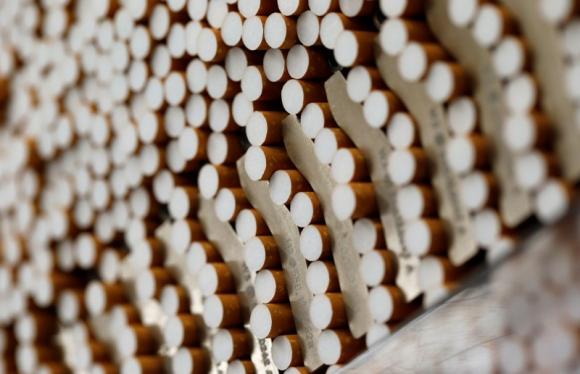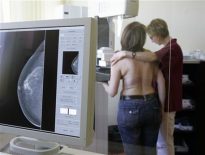(Reuters) – It takes a British American Tobacco (BATS.L) factory machine three minutes to load 4 million cigarettes onto a truck in northern Bavaria – but it can take a lot longer to figure out whether those cigarettes end up where they should.

So the EU is asking tobacco firms to do more to track and trace their goods, in order to tackle a huge black market and ultimately prevent some of the 700,000 deaths each year in the EU from smoking-related diseases.
The legislation, which takes effect over the next two years, is part of a package that also slaps no-holds-barred pictures of the health effects of smoking on packets, and bans menthol. Alongside it, an international treaty ratified by 178 countries – the Framework Convention on Tobacco Control (FCTC) – aims to ensure similar measures are introduced right across the world.
There’s one problem, however: The big international tobacco firms – Philip Morris International (PM.N), British American, Japan Tobacco (2914.T) and Imperial Tobacco (IMT.L) already use a track and trace system called Codentify, developed by Philip Morris, which they say works perfectly well.
They do not want to have to add costly third-party systems to their massive operations, which turned out more than 2 trillion cigarettes last year.
Our biggest concern is proprietary solution providers pushing unproven solutions on to governments, said Daniel Hubert, BAT’s supply chain tracking and verification program manager and a director of the Digital Coding & Tracking Association (DCTA), a group made up of BAT, Philip Morris, Japan Tobacco and Imperial.
But tobacco industry critics say Codentify is simply not good enough, because it focuses too much on production and does not store product codes or track them. Last year Luk Joossens, advocacy officer of the Association of European Cancer Leagues, and Anna Gilmore, director of the University of Bath’s Tobacco Control Research Group, published a report listing the system’s technical and ethical limitations.
Codentify is not up to the task and worse than that, it puts the fox in charge of the hen-house, Gilmore told Reuters.
In response, Big Tobacco acknowledges that Codentify only does part of the job, and says critics fail to include third-party technology used alongside it to make it fully compliant.
EU member states have two years to bring their national legislation into line with the new tobacco directives. So most of the new rules will apply in the first half of 2016. In the interim, experts are analyzing the feasibility and cost of a range of alternative track and trace options from security printing companies and IT/data processing companies, and will report back at the end of the year.
For now it is not clear what they will recommend, but industry sources doubt Codentify will be adopted without at least significant changes.
There’s a lot of resistance to allowing the tobacco industry to use its own technology, said Euromonitor International analyst Shane MacGuill.
WHO MAKES POLICY?
Track and trace technology aims to pinpoint cracks in the supply chain where cigarettes fall into illicit trade, which according to the WHO, makes up about 10 percent of the global tobacco market, robs governments of over $30 billion a year in taxes and undermines public health goals with a cheap supply.
In order to comply with the EU laws, governments must impose complex control systems on manufacturers that track every pack from factory floor to store shelf, through all the hands it passes with details such as time and place of production, intended market, names of buyers and payment records.
The industry has reason to help. By stamping out illicit trade, it would recoup millions in annual revenue lost to counterfeits and lower the chances of costly seizure payments when its goods turn up contraband.
Over three days in March, private investigators working for Philip Morris say they made 23 purchases of illicit tobacco in London’s central borough of Westminster, from well-known international brands to so-called illicit whites – fake cigarette labels made outside the EU especially for smuggling.
If we’re finding product here, what is it like elsewhere in more of the deprived areas? said Will O’Reilly, a former Detective Chief Inspector with the Metropolitan Police now working for Philip Morris, the world’s No. 1 tobacco company.
In 2012 Philip Morris donated 15 million euros ($20.42 million) over three years to Interpol – the world’s biggest police force, which had total operating income of 70 million euros that year – to help it fight the black market.
Interpol says the donation was in full compliance of its rules which allow it to accept private money when it is in the best interests of the organization to do so … and when Interpol itself decides how the money is to be used.
But skeptics say that help from the industry allows it to maintain influence with governments and public agencies.
This is particularly worrying, they say, given historical evidence of links between the industry and smugglers: Several cigarette makers have been accused of oversupplying markets with porous borders on the edge of the EU, or other low-tax markets, in order to benefit from the additional revenues.
In 2004 Marlboro-maker Philip Morris struck a $1.25 billion deal with EU regulators to end a legal dispute over its role in smuggling cigarettes into the bloc. Japan Tobacco, maker of the Winston and Camel brands, settled a similar dispute in 2007, and BAT and Imperial, maker of Gauloises, reached voluntary agreements with EU regulators in 2010. Their combined payments were around $2 billion.
SCALE OF THE CHALLENGE
The industry’s current standard, Codentify, which is used in 50 world markets, focuses on product authentication, volume control and tax verification. It does not store codes, create a database or register the product’s journey – hence critics’ claims that the system is inadequate.
Back at BAT’s plant midway between Berlin and Munich, Bernd Meyer, head of manufacturing for Western Europe, oversees operations that track cartons of Lucky Strikes and Pall Malls from production line to first customer, usually a wholesaler.
However, shipments often pass through several independent distributors after that, and gathering that information is the biggest challenge.
Another difficulty is tracking individual packs – which are packed inside cartons that are fitted into cases that are placed onto pallets, which are loaded onto trucks that leave Bayreuth, BAT’s largest factory by volume, at a rate of about 40 per day.
Meyer says he is in the process of implementing changes expected to cost 100 million to 200 million euros, some of which relate to track and trace.
With the Codentify technology Meyer is installing, the Digital Coding & Tracking Association says each production line will have a code generator that feeds into a central server overseen by a government. Each pack would be printed with unique codes, which would link to the codes on cartons and cases and be scannable in transit – allowing the government and customs agents to trace its journey.
We are intensifying our work in this area, Meyer told Reuters. It’s a lot of money because you have to equip every single machine with that track and trace technology.
Nonetheless, critics still question whether Codentify meets the independence test, especially that of the FCTC, which states that obligations assigned to a party (country) shall not be performed by or delegated to the tobacco industry.
To get around this, the industry says it is willing to hand over Codentify’s intellectual property or open itself to audits. We’re open to any level of inspection, said BAT’s Hubert, on behalf of the DCTA.
THE PRICE OF INDEPENDENCE
Any alternative system will be pricey, insiders say.
By definition, any system where they self-regulate and where they choose the functionality they want is going to be cheaper than any system that comes from the outside, said Christine Macqueen, director of corporate affairs for SICPA, a Swiss company that sells rival authentication technology.
It is also likely to be multi-layered as countries will have different needs and thus need different functionalities.
Several different options are on the table at the moment.
SIPCA, which operates a tobacco tracking programs in Brazil and Morocco and could benefit from Codentify’s rejection, says it offers among other things data aggregation from pack to carton and carton to master case, and supply chain visibility by consolidating data from SICPA systems and other sources.
Britain’s De La Rue (DLAR.L), which also makes banknotes and passports, provides authentication systems alongside track and trace solutions that include tax stamps, although some in the industry worry that affixable stamps can be removed.
In fact, the EU’s feasibility experts are more likely to recommend standards or business requirements than specific technologies, says Michael Eads, president of Sovereign Border Solutions, one of the companies carrying out the EU’s feasibility study.
Their aim, he added, is to find a standard that takes into account not just the mandates of law enforcement and public health but also consumer protection and business efficiency.
That’s the holy grail, Eads told Reuters, then added: Whether or not we can achieve that with this particular project, I’m not sure.
($1 = 0.7345 Euros)
(Editing by Sophie Walker)





